© Copyrights Tai Chi Productions 2007. All rights reserved, no part of this article may be reproduced in any forms or by any means, without permission in writing, except for non-profit educational purpose. For example: you can photocopy this article for a friend, paying student, or conference participant as long as this article is not included as part of your charge
Qigong is one of the oldest exercises in Chinese history, dating back more than one thousand years.
There are numerous types of Qigong. Generally speaking, Qigong is a variety of breathing, gymnastic, and meditative exercises. In Chinese, Qi means several things; the most common meaning of Qi is air. Here, Qi means the life energy inside a person. This life energy comes from the combination of three things: the air breathed in through the lungs, essential Qi from the kidney, and the Qi absorbed from food and water through the digestive system. Qi circulates throughout the body, performing many functions to maintain good health. The stronger Qi you have, the healthier and stronger you are. The word Gong means a method of exercise that requires a great deal of time in which to become proficient.
Simply put, Qigong is a breathing exercise that requires regular practise, and is especially beneficial for health and mental relaxation. Qigong is an integrated part of Tai Chi.

1. The Posture of Infinity – for posture awareness
According to ancient Chinese philosophy, the universe started from a vast void, the infinity. It is called wu-ji in Chinese. The main focus of this qigong exercise is for posture awareness.
Q1 Stand upright but relaxed, feet apart, knees relaxed, eyes looking forward, chin tucked in, shoulders relaxed.
Cleanse your mind and focus on the correct posture-upright without being tense.
2. The Posture of Tai Chi – for Dan Tian awareness
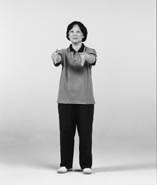
From the vast void, the infinity, the universe developed into a state of Tai Chi, the supreme ultimate. It is like an immense ball comprised of two opposite and complementary halves, yin and yang. The main purpose of this is for Dan Tian awareness.
Dan Tian is the area approximately three fingerbreadths from the naval. It is the centre of Qi.
From Q1Posture awareness
Q2A: Slowly bring your hands up, palms facing each other, breathing in.
Q2B: Bring hands towards chest, bending knees slightly.
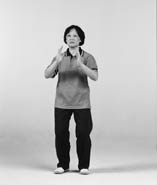
Focus and concentrate on the Dan Tian. When you get slightly tired, stretch your hands out to the previous posture, bring your hands down and slowly stand up. Dan Tian is an area three finger breadth below the belly button (Umbilicus) 3. The Posture of Opening and Closing – for breathing awareness
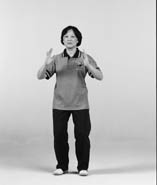
This is the working of yin and yang. Closing is yin and opening is yang. The purpose of this exercise is for breathing awareness. Breathing is the centre of all qigong exercise. The ancient Chinese believed breath is life and life is energy.
Q3A: From the previous posture, breathe in, open hands to shoulder width. If your knees feel tired, gently straighten them.
Q3B: Breathe out, pushing hands towards each other as close as possible without touching.
Gently bend your knees if you have straightened them in the previous move.
Continue opening and closing hands several times. Complete the exercise by stretching your hands forward, return to the previous position and straighten your knees.
Do this exercise three or less times to start with and then more as you are get stronger.
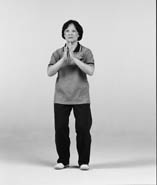
As you breathe in and out, imagine there is a gentle magnetic force between your palms. Pull against this resistance as you breathe in and push against it as you breathe out.
Keep your mouth closed but not tight, tongue lightly touching the upper palate
Using Abdomenal breathing method:
Imagine that as air is travelling through your nose, down the trachea (airway to the lungs), and filling the lungs and then the abdomen. Your abdomen is extended with the air, making it bulge gently outward. Then as you breathe out the abdomen contracts. You can mentally picture the air expelling from the abdomen, lungs, trachea and finally through your nose. (Physically, air does not enter your abdomen. This is a method using guided imagery to help utilise your diaphragm to open up more air space in your lungs.)
Using the reverse abdominal breathing method

Using the same imagery let air go through to the abdomen, except when breathing in the upper part of abdomen (where the stomach is) expands, and lower abdomen contracts. When breathing out (which is often faster when delivering force) the upper abdomen flattens and the lower abdomen extending outward. This is a more advanced method often adapted by Chen stylists. This method allows the Qi to sink to the Dan tian quickly and powerfully when delivering force which is more prevalent in Chen style. Chen style is not a suitable style to start with by people with arthritis … might be later when you are stronger.
4. The Posture of Raising and Lowering – for Qi awareness
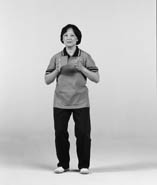
Q2A : Slowly bring your hands up, breathing in.
Q4B:Bring your hands up along your chest and breath in.
Continue moving in the loop, standing up as you breathe in and bending down as you breathe out. Finish off after doing the exercise three times.
When you breathe in, visualise your Qi moving up to the middle of your chest. When you breathe out visualise your Qi moving down to the Dan Tian. It doesn’t matter if you don’t understand what Qi is. Simply think about this area as you breathe in and out. As your Tai Chi improves, you will be able to understand and feel the Qi. While the sensation of Qi is different to different people, for most, it feels like a warm and slightly heavy sensation.
Original article and pictures take taichi-4d7hcyno75y7zbms.netdna-ssl.com site